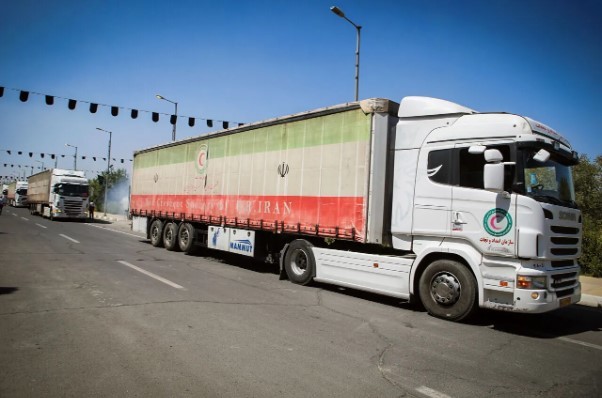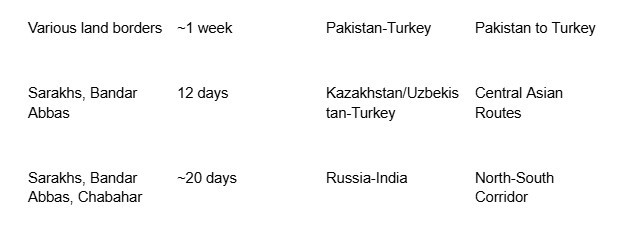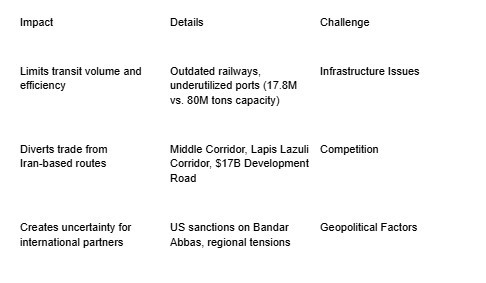Transit via Iran and Everything You Need to Know
Transit via Iran and Everything You Need to Know
From Ahsan Raza
Transit via Iran and Everything You Need to Know
Subscribe to follow campaign updates!
More Info
Transit via Iran refers to the use of Iran as a land bridge for the movement of goods and passengers between Europe, Central Asia, and the Middle East. Located at the crossroads of these regions, Iran has historically been a key player in trade routes, dating back to the ancient Silk Road. In recent years, due to geopolitical shifts and the need for alternative trade routes, Transit via Iran has gained significant importance in international logistics.

Understanding Transit via Iran
Transit via Iran involves the transportation of goods and passengers through Iranian territory, utilizing its road, rail, and port infrastructure. This transit serves various purposes, including connecting landlocked countries to international markets, reducing transit times, and lowering transportation costs. Historically, Iran's strategic location has made it a natural choice for transit. The country shares borders with Turkey, Iraq, Pakistan, Afghanistan, Turkmenistan, Azerbaijan, and Armenia, providing access to multiple regions. Additionally, Iran has access to the Persian Gulf and the Caspian Sea, which are vital for maritime trade.
In modern times, Transit via Iran has seen a resurgence, particularly with the opening of new trade routes and the development of infrastructure projects. For example, in 2021, a new trade route was established between the United Arab Emirates (UAE) and Turkey via Iran, allowing trucks to travel from Ras al Khaimah in the UAE to Turkey through Iran (Transit via Iran). This route significantly reduces the transit time compared to the traditional sea route via the Suez Canal.
Key Transit Routes via Iran
Several key transit routes pass through Iran, connecting different parts of the world, often transporting by trucks:
1. UAE to Turkey via Iran: This route, opened in October 2021, allows trucks to travel from the UAE through Iran to Turkey, reducing the transit time from 21 days by sea to just 6 days by road. The route uses the Bandar Abbas port and the Shahid Bahonar terminal in Iran. Approximately 1,000 trucks have used this route since its inception, carrying goods like consumer durables, foodstuff, cosmetics, machinery, spare parts, and personal belongings.
2. Pakistan to Turkey via Iran: Pakistan has also started using an overland route through Iran to reach Turkey, cutting down the travel time for goods from South Asia to Europe from up to 40 days by sea to as little as a week by road. This route enhances connectivity for South Asian markets.
3. Central Asian Routes: Central Asian countries like Kazakhstan, Uzbekistan, and Tajikistan are increasingly using Iran as a transit hub to connect with Turkey and Europe. For instance, in June 2022, a freight train from Kazakhstan traveled through Iran to Turkey in 12 days, demonstrating the efficiency of this route. Tajikistan launched a multimodal route from China to Turkey via Uzbekistan, Turkmenistan, and Iran in October 2022.
4. North-South Trade Corridor: This corridor connects Russia, Iran, and India, with goods being transported from Russia through Iran to India via the Bandar Abbas port. In July 2022, a train from Russia arrived at the Sarakhs station on the Turkmenistani-Iranian border and continued to Bandar Abbas for onward shipment to India. Uzbekistan has also utilized the Chabahar port for this corridor, with a trip from India to Almaty taking 20 days.


Benefits of Transit via Iran
Transit via Iran offers several advantages that make it an attractive option for global trade:
- Reduced Transit Times: By using land routes through Iran, goods can reach their destinations much faster than by sea. For example, the UAE-Turkey route reduces transit time from 21 days to 6 days, and the Pakistan-Turkey route cuts travel time from 40 days to about a week.
- Lower Costs: Shorter transit times translate to lower costs for insurance, refrigeration, and other time-sensitive expenses. Land transport, particularly by trucks, can also be more cost-effective for certain types of goods compared to sea freight.
- Easing Supply-Chain Shortages: By providing alternative routes, Transit via Iran helps alleviate bottlenecks in global supply chains, especially during times of crisis or when traditional routes, like the Suez Canal, are disrupted. This is particularly beneficial for landlocked Central Asian countries seeking access to international markets.
- Economic Benefits for Iran: Transit via Iran generates significant revenue for the country. Each ton of cargo earns approximately $150 and creates 40 jobs. If Iran were to reach its transit capacity of 80 million tons annually, it could earn $8 billion, equivalent to 25% of its non-oil exports.
Challenges and Obstacles
Despite its potential, Transit via Iran faces several challenges that need to be addressed:
- Infrastructure Issues: Iran's transportation infrastructure, while extensive, suffers from underutilization and outdated equipment. For instance, out of 900 locomotives, nearly half are out of service due to resource constraints. The transit volume in the last Iranian calendar year was 17.8 million tons, far below the capacity of 80 million tons. Northern ports have a capacity of 35 million tons annually but handle only 6 million tons.
- Competition from Other Corridors: Other transit corridors, such as the Middle Corridor (Trans-Caspian International Transport Route) and the Lapis Lazuli Corridor, are being developed, offering alternative routes that may compete with Transit via Iran. These corridors, like the $17 billion Development Road, connect regions like Turkmenistan, Azerbaijan, and Turkey to Europe, sometimes bypassing Iran.
- Geopolitical
Factors: Sanctions and geopolitical tensions can impact the viability of
Transit via Iran. For example, parts of the Bandar Abbas port are under US
sanctions, though regional countries are increasingly ignoring these
restrictions to utilize the route. The geopolitical landscape, including
tensions with Western countries, adds complexity to Iran’s role as a
transit hub.
![]()
Conclusion
Transit via Iran is a vital component of regional and international trade, offering significant benefits in terms of reduced transit times, lower costs, and economic opportunities for Iran. By leveraging its strategic location and improving its infrastructure, Iran has the potential to become a major transit hub, connecting Europe, Central Asia, and the Middle East. While challenges such as infrastructure limitations and geopolitical tensions remain, ongoing developments and regional cooperation suggest a bright future for Transit via Iran. As global trade evolves, this route will likely play an increasingly important role in facilitating efficient and cost-effective transportation.
Campaign Wall
Join the Conversation
Sign in with your Facebook account or email.
